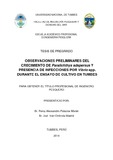Por favor, use este identificador para citar o enlazar este ítem:
https://hdl.handle.net/20.500.12958/3020Registro completo de metadatos
| Campo DC | Valor | Lengua/Idioma |
|---|---|---|
| dc.contributor.author | Palacios Morán, Percy Alexsandro | - |
| dc.contributor.author | Ordinola Madrid, Joel Iván | - |
| dc.date.accessioned | 2016-05-30T17:26:50Z | - |
| dc.date.available | 2016-05-30T17:26:50Z | - |
| dc.date.issued | 2014 | - |
| dc.identifier.uri | https://hdl.handle.net/20.500.12958/3020 | - |
| dc.description | Tesis (Ingeniero Pesquero) .- Universidad Nacional de Tumbes. Facultad de Ingenieria Pesquera y Ciencias del Mar. Escuela Académica Profesional de Ingeniería Pesquera. | es_ES |
| dc.description.abstract | La presente investigación es para evaluar la posibilidad de cultivo de Paralichthys adspersus (lenguado común) bajo las condiciones fisicoquímicas del agua del mar de la región de Tumbes. Luego de aclimatar 100 ejemplares de P. adspersus a la temperatura de 23,4 °C y 32 ‰ de salinidad, se distribuyó en dos tanques iguales de 1000 L a una densidad inicial de 50 ind./m3, realizando recambios diarios de 50 %, alimentados a saciedad durante todo el día con alimento balanceado de 42 % de proteínas (consumo total de alimento: 413 g). Mensualmente se muestreo el 100 % de los peces, determinando su tasa de crecimiento especifico, supervivencia y presencia de infecciones por Vibrio spp. La tasa de crecimiento específico durante esta experiencia fue de 0,41 %/día, la supervivencia luego de la aclimatación fue de 100 % hasta los 42 días de cultivo que alcanzó el 0 %, debido a la infestación por protozoarios parásitos del genero Amyloodinium en las branquias, descartando en todo momento la presencia de infecciones por Vibrio spp. La presente investigación permite precisar que P. adspersus se adapta a las condiciones fisicoquímicas de la región de Tumbes | es_ES |
| dc.description.abstract | ABSTRACT: The present research is to evaluate the harvest possibility of Paralichthys adspersus under the fisico-chemical conditions of Tumbes Region Water Sea. Then, to temperate a hundred samples of P. adspersus to the temperature of 23,4 °C and 32 ‰ of salty, it was distributed in two equal tanks of 1000 L to a initial density of 50 ind./m3, realizing daily recharges of 50 % fed samples to thirstiness during all day with balanced food of 42 % of proteins (total consume of food: 413 g). It took samples of 100 % fish monthly, determining that their specific growth rate, survival and infections presence by Vibrio spp. The specific growth rate during this experience was of 2,9 %/ day, after the acclimatization, the survival was of 100 % until 42 days of harvest which got 0 %, due to the infestation of parasites of the Amyloodinium gender into the bronchia, outstanding at all time the presence of infections by Vibrio spp. The actual investigation lets precise that P. adspersus adoptees in the physic-chemical conditions of Tumbes Region. | - |
| dc.language.iso | spa | es_ES |
| dc.publisher | Tumbes | es_ES |
| dc.rights | info:eu-repo/semantics/openAccess | es_ES |
| dc.rights.uri | https://creativecommons.org/licenses/by/4.0/ | - |
| dc.source | Instituto del Mar del Perú - IMARPE | es_ES |
| dc.source.uri | Repositorio Digital IMARPE | es_ES |
| dc.subject | Paralichthys Adspersus | es_ES |
| dc.subject | Vibrio | es_ES |
| dc.subject | Tumbes | es_ES |
| dc.subject | Lenguado | es_ES |
| dc.subject | Cultivo | es_ES |
| dc.title | Observaciones preliminares del crecimiento de Paralichthys adspersus y presencia de infecciones por Vibrio spp. durante el ensayo de cultivo de Tumbes | es_ES |
| dc.type | info:eu-repo/semantics/bachelorThesis | es_ES |
| Aparece en las colecciones: | Tesis de Grado | |
Ficheros en este ítem:
| Fichero | Descripción | Tamaño | Formato | |
|---|---|---|---|---|
| Ordinola y Palacios.pdf | 1,98 MB | Adobe PDF |  Visualizar/Abrir |
Este ítem está sujeto a una licencia Creative Commons Licencia Creative Commons

